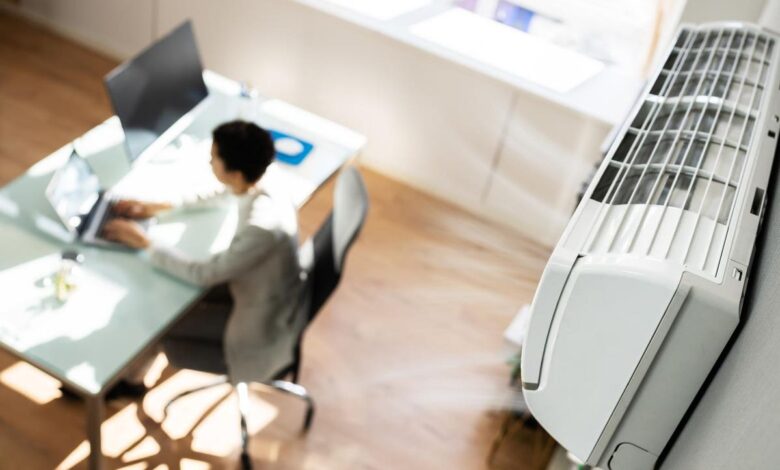How Entrepreneurs Can Keep Their Office Space Operating Well

Air conditioner above employee
While spring brings the beauty of blooming flowers and pleasant temperatures, it also ushers in a period of heightened weather volatility. As warm and cold air clashes, it often leads to the development of strong thunderstorms, heavy rainfall, hail, and even tornadoes in some regions.
Recently, one of our offices had some significant weather damage that had to be repaired. When this happened to me, I looked at options that could have prevented some of these issues. As much as I want to be mad at mother nature, as a business owner one of my responsibilities is to keep operations running smoothly. Knowing how to react to rapidly changing weather can ensure safety and minimize the impact of severe storms. Below, I’ll go over a few ways you can prepare and protect your office from extreme weather.
Conduct a Risk Assessment
It’s necessary to understand the specific risks your office space faces during extreme weather, and a risk assessment will provide that information. You’ll identify areas that could be especially susceptible to damage. Look at windows, doors, and your roof. If water gets in, this is usually where a breach will occur. You’ll also want to think about landscaping features that could cause damage. You don’t want high winds picking up patio furniture and hurling it through a window.
Tall trees near your building can be especially risky, and they might need to be trimmed or cut down. If they fall, they can cause structural damage or even injure your employees. Debris can damage utility lines, HVAC systems, lighting, water lines, and your roof. It can also limit access to the property if a roadway is blocked.
While you can definitely do a walk through to look for risks yourself, you might consider consulting with a professional risk assessor or structural engineer to conduct a thorough evaluation. They can recognize potential issues that may not be immediately apparent and offer solutions.
Reinforce the Building
Strong winds associated with hurricanes and tornadoes can easily damage your office building, but there are ways to give it a fighting chance:
Protect Windows and Doors
When your office is located somewhere that often experiences severe weather, it’s worth investing in impact-resistant doors and windows. If storms are less common, you could install protective coverings like storm shutters or plywood panels instead. You want to ensure all entry points are properly sealed to prevent water from coming in during heavy rain or flooding.
Secure Roofing and Siding
Roof damage is a common issue during severe weather events. Unfortunately, it’s also some of the most serious damage because it can lead to leaks and structural instability. Inspect your building’s roof regularly for loose shingles, damaged flashing, or signs of deterioration. Reinforce roofing materials as needed and consider installing hurricane straps or braces if you live in an area that sees storms regularly. Similarly, you can reinforce exterior siding to withstand high winds and flying debris.
Implement Flood Prevention Measures
Flooding can destroy your office. It can ruin equipment, documents, and even the building itself. If your office is located in a flood-prone area, you could install flood barriers or place sandbags around entry points to mitigate risks. You should also think about elevating electrical panels and HVAC systems. Considering ductless mini-split systems from companies like HVACDirect.com can be advantageous in flood-prone areas as they are typically installed higher on walls and are less susceptible to water damage.
To protect your people—which is the most important thing—make sure that your office has a comprehensive flood evacuation plan in place as well. This plan should include clear evacuation routes and designate assembly points at safe locations outside the flood zone. Assign specific roles and responsibilities to designated personnel, such as evacuation coordinators and first aid responders, to ensure an organized response.
Choose Backup Power and Communication Systems
Power outages are common during extreme weather. If you experience one, just know it’ll disrupt essential operations. It’s smart to invest in backup power sources such as generators or uninterruptible power supplies to keep critical systems running. Additionally, alternative communication channels such as satellite phones or mobile hotspots can help you stay connected with employees or clients during outages.
That said, if you know your workers are safe at home, always prioritize their safety over business. Avoid pressuring them to continue working if it compromises their safety. A few days of downtime won’t bankrupt your business, and if it does, there are likely bigger issues at play. Ensuring that employees feel safe and supported during emergencies can foster trust and loyalty, which are invaluable assets for any organization in the long run.
Develop an Emergency Response Plan
One of the most important things you can do when preparing for an emergency is to have a plan. Clearly outline roles and responsibilities for employees, designate evacuation routes, and establish protocols for shutting down operations and securing sensitive equipment.
For instance, you could assign your operations manager the responsibility of overseeing the shutdown of all non-essential operations and securing sensitive equipment. This would include telling staff to power down computers to prevent damage from power surges. You might tell your IT personnel to ensure critical data is backed up and securely stored, either physically or on cloud-based servers, to mitigate the risk of data loss. They should also shut down servers and network infrastructure to minimize the risk of hardware damage or data corruption.
Conduct regular drills to ensure that all employees are familiar with emergency procedures and know how to respond effectively in crisis situations. You might feel like you’re in high school again meeting up in the parking lot and taking roll call, but there’s a reason you practice. The more familiar everyone is with what they need to do, the more confident they’ll be during actual emergencies. It reduces panic and leads to a more coordinated response if a crisis occurs.
It’s Better to Be Safe Than Sorry
While all this talk about emergency preparedness may seem extreme, taking the time now to prepare will be worth it if you do have to face a severe weather emergency. Protecting your office space and your team requires proactive planning, and the better your plan, the better off you’ll be. Beside ongoing maintenance and the tips above, make sure you also have adequate insurance coverage to protect your office space from potential damage.
Your business is an investment, and you don’t want to lose it because you assumed it would always be safe. The world is unpredictable. Review your existing insurance policies to ensure they provide sufficient coverage for property damage, business interruption, and other weather-related risks. Depending on your location, you might want to purchase additional coverage to address specific vulnerabilities identified during your risk assessment.
Hopefully, by following these suggestions, you can minimize the impact of extreme weather events on your office operations and ensure the safety of your employees.



